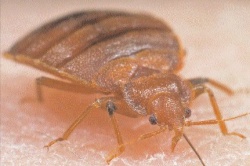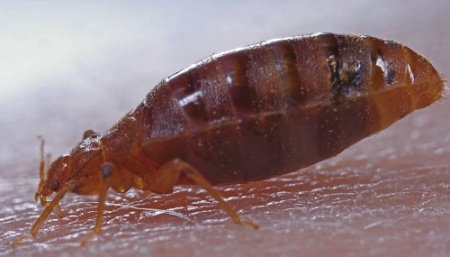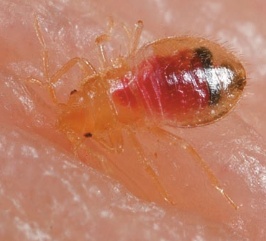The re-emergence of Bed Bugs
James A. Walker

Figure 1 - an adult bed bug (Cimex lectularius). Photograph by Gary Alpert of Environmental Health and Safety, Harvard University.
Sleep tight, don't let the bed bugs bite.
This old saying has gained renewed relevance in the western world in recent years. Reports have been made since the mid-1990s, both in the medical press and national newspapers, of the reemergence of infestations of the Common bed bug (Cimex lectularius) in many developed countries (Paul and Bates, 2000; Boase, 2001; Vandam, 2003; Hall and Yapp, 2004; Cleary and Buchanan, 2004). Previously, this species has been so rare in the U.K., that individual sightings have been considered worthy of publication (George, 1988). However, since 1995, infestations have almost doubled annually in the U.K. (Boase, 2004). This trend has also been seen in other parts of Europe, the United States and Australia. Unfortunately I have recently had first-hand experience of these unpleasant insects in my home in the United States.
Bed bug species
C. lectularius is distributed worldwide and is the most frequently encountered of the Cimicidae family that are known to feed on humans. In tropical regions, including Florida, the Tropical bed bug (C. hemipterus) is also very common. C. hemipterus is very similar in appearance, but somewhat larger than C. lectularius. The ranges of these two species overlaps and they have been reported to interbreed, albeit unsuccessfully (Newberry, 1988). Leptocimex boueti is associated with both humans and bats in the tropics of West Africa. In addition, other species may sometimes feed on humans or household pets in the absence of their normal hosts. For example, the Batbugs native to the British Isles (C. pipistrelli and C. dissimilis) can feed on human blood if, for instance, a bat control programme has eliminated their normal hosts (Whyte et al., 2001). Similarly the Pigeon bug (C. columbarius) may occasionally enter homes and annoy the occupants (Southwood and Leston, 1959). The Martin bug (Oeciacus hirundinis), while not strictly a bed bug, is a closely related genus primarily affecting birds and has been reported to humans (Southwood and Leston, 1959). In North America, opportunistic feeders on humans include the Batbugs (C. pilosellus and C. adjunctus), the Chimney Swift Bug (Cimexopsis nyctalis) and Haematosiphon inodora, which primarily infests poultry (Jacobs, 2004).
Bed bug description and biology
Adults of C. lectularius are 5-7 mm in length, oval in shape, flat, wingless and reddish-brown in colour (Figure 1). They are usually found in bedrooms as they generally feed at night when the host is asleep. During the day the bugs hide, often in crowds, behind loose wallpaper, in mattress seams, between floorboards, in cracks in walls, behind pictures and in furniture and electrical fittings. Feeding takes about 5-10 minutes and up to seven times their body weight in blood can be ingested in one feed (Figure 2). Females lay about 200-500 eggs (Figure 3), usually at the rate of three or four a day, in cracks and crevices in the floor or bed. Newly hatched bugs begin feeding immediately (Figure 4).

Figure 2 - Bed bug nymph (Cimex lectularius) feeding on a human. Note the body heavily engorged with blood. Each nymphal stage requires a single blood meal before moulting to the next stage. Photograph by Gary Alpert of Environmental Health and Safety, Harvard University.

Figure 3 - Eggs of bed bugs (Cimex lectularius). Approximate length of egg is 1 mm. A female bed bug can lay between 300-400 eggs in her lifetime. Photograph by Gary Alpert of Environmental Health and Safety, Harvard University.

Figure 3 - First instar nymph of Cimex lectularius (about 1.3 mm in length) feeding on human. Its first blood meal can be seen clearly through the translucent body. Photograph by Gary Alpert of Environmental Health and Safety, Harvard University.
Lifecycle
There are five nymphal stages, each requiring a full meal of blood before the next moult. Given ample food and optimal temperature conditions, they can mature into adults within one to two months. Adult females live for six to twelve months and can reproduce throughout the year under ideal conditions. Even when deprived of blood, individual bugs can survive a year or more, allowing infestations to persist in empty properties or in stored furniture.
Bed bug bites
Most people, as I did, become aware of sharing their bed with these insects because of their bites. Although not known to transmit any diseases that can affect humans, bed bug bites can be very distressing. The degree of reaction to the bite varies greatly, with some individuals experiencing no discomfort, while others develop an allergic reaction with an itchy red swelling lasting for weeks. I found the itching of the bites to be so intense that it could only be relieved by using hydrocortisone cream. Untreated, the red welts took several days to disappear. Initially I was unsure what the cause of the irritations was. This led to many sleepless nights and a great deal of anxiety. Friends and colleagues suggested hives, fleas and food allergies. However, I eventually discovered one of the culprits, when I awoke after being bitten one morning at 2 o'clock and quickly examined the bed sheets. I spotted a bed bug rapidly retreating to the edge of the bed as I switched on the light. Further investigation of the bed revealed seven more bugs, all of which were nymphs, hiding in the corners of the mattress under the sheets.
On the advice of a local pest control service, I disposed of my mattress and bed frame. All my bedding and clothing from the bedroom was washed at high temperature, after being transported in sealed plastic bags to prevent contamination of other parts of the house. Everything else in the bedroom was similarly packed in plastic bags and placed in a -20°C freezer for a day to ensure that any bugs or eggs were destroyed. The controllers then treated the room with two pesticides: Gentrol (from Zoecon) contains the active ingredient (S)- Hydroprene, which acts as an insect growth regulator by disrupting the moulting process and P.I. Contact Insecticide (from Whitmire Micro- gen) is a residual pesticide containing pyrethrin. Since the bugs can hide in the smallest of crevices, treatment was extremely thorough. Consequently, I slept in another room for several weeks afterwards and delayed buying a new bed until I was certain that no intruders remained. I was fortunate that the bugs appeared to all be nymphs and so were not yet reproducing since the eradication of a full-blown infestation is often extremely difficult. It has been reported that evidence of a heavy bed bug infestation can be an unpleasant almond- like smell created by the bug's 'stink glands', or finding blood and faecal material on sheets and pillows or cast nymphal skins (Crissey, 1981). Thankfully I was able to prevent such a full-blown infestation from occurring in my home.
The rise of bed bugs
It is unclear exactly why bed bugs have made such a successful comeback in developed countries. In the 19th century it was estimated that 75% of British houses were infested. In 1933 a Ministry of Health report said: "In many areas all the houses are to a greater or lesser degree infested with bed bugs" (Ministry of Health, 1933). The introduction of domestic vacuum cleaners, the widespread use of DDT and a more coordinated approach to public hygiene all contributed to the virtual eradication of bed bugs in developed countries by the 1980s. In contrast, infestations in developing countries have remained high (Boase, 2004). The use of DDT has, of course, been discontinued since the 1970s, except for some tropical regions. In addition, bed bugs may have developed resistance to other pesticides. Pyrethroids, synthetic forms of pyrethrins (natural insecticides found in chrysanthemum flowers), have traditionally been used to treat bed bug infestations. However, research from East Africa has shown an association between the use of pyrethroid-treated mosquito nets and the growth of resistance to this insecticide in bed bugs (Myamba et al., 2002). Changes in the pest control industry may have also inadvertently benefited bed bugs. The control for cockroaches has moved away from traditional methods of chemical application towards specific edible baits which have no impact on bed bugs as former methods have done (Koehler and Harlan, 2001).
In the past bed bugs were usually associated with poor households, rundown hotels, overcrowded hostels and refuges for asylum seekers. However, recent reports of infestations have included up-market hotels and respectable neighbourhoods. The huge increase in international travel is thought to be a major factor in their dissemination. Obviously bed bugs do not discriminate between backpackers and business travellers and by hitching a ride in luggage, they can spread far and wide. Although the majority of the recent bed bug infestations in the U.K. have been due to C. lectularius, the Tropical Bed bug (C. hemipterus) has been found in London in the last two years (Clive Boase, pers. comm.). C. hemipterus has also recently appeared in Australia for the first time, possibly imported by back-packers (Doggett et al., 2006). Some case reports link bugs with furniture imported from tropical countries and the U.S.A. (Paul and Bates, 2000). The sale of second-hand furniture, clothing and books, in which bugs or eggs may be hiding, particularly at car boot sales and junk stores, has also been cited as a possible mechanism of spreading (Coghlan, 2002). Bed bugs can also move between properties, through cracks in walls and between floors. Central heating also allows them to breed all year round. In the past, harsh winters would provide a check on bed bug populations in poorly heated houses.
How did the bed bugs arrive in my apartment? It is likely that I unwittingly introduced either eggs or nymphs on a second-hand bookcase that I moved into my bedroom, since I started to notice being bitten a month or two later. I live in a rented house in East Boston in Massachusetts, an area populated by predominantly Hispanic immigrants from South and Central America. There is a tradition here of leaving unwanted second-hand furniture on the street for other residents. Although bed bugs are a major problem in this district, I believe that many people are often unaware of exactly what is biting them at night since bed bugs are so small and elusive. On refuse collection days there are always seemingly good mattresses put out for disposal. However, without subsequent insecticide treatment of the building the problem will reoccur. The pest controller that treated my house said that he has seen a ten-fold increase in bed bug infestations in the last two years in Boston (Thomas Drapeau, pers. comm.).
Since my encounter with bed bugs, I have met many others who have similarly suffered. Other districts in Boston such as Brighton and Allston have severe bed bug problems, which have been described as epidemics in the local press. New York City has also been particularly hard hit; a friend living in Harlem found them in his apartment, along with the more conspicuous cockroaches. At a recent cocktail party I overheard a student recounting his bed bug woes. The infestation was so extreme, with hundreds of bugs under his bed, that he was forced to move out. By the end of the evening several other guests had admitted that they had encountered bed bugs. Although this is not something one would normally advertise at a social gathering, there was a certain kinship in having shared our homes with these pests.
There is much speculation as to whether the reemergence of bed bugs is a transient phenomenon. Although they are not associated with any diseases, they are a great nuisance and represent a public health problem if left unchecked. New pesticides coupled with greater public awareness will likely reduce infestations. However, for the time being, bed bugs are making a comeback.
Acknowledgements
I would like to thank Thomas Drapeau from Freedom Pest Control Services (Georgetown, MA, U.S.A.), Clive Boase of the Pest Management Consultancy (Haverhill, U.K.) and Gary Alpert of Environmental Health and Safety, Harvard University (Cambridge, MA, USA) for discussions and information. I am particularly grateful to Gary Alpert for supplying the photos used in this article.
References
Boase, C.J. (2001) Bed-bugs - back from the brink. Pesticide Outlook 12 (4), 159-162.
Boase, C.J. (2004) Bed-bugs - reclaiming our cities. Biologist 51 (1), 1-4.
Cleary, C. J. and Buchanan, D. (2004) An Emerging U.S. Infestation. The Nurse Practitioner. 29 (6), 46-48.
Coghlan (2002) Bedbugs bit back. New Scientist 5 Oct, 10.
Crissey, J.T. (1981) Bedbugs. An old problem with a new dimension. Int. J. Dermatol. 20: 411-414.
Doggett, S.L., Geary, M., Crowe, W. J., Wilson, P. and Russell, R.C. (2006) Department of Medical Entomology, ICPMR, New South Wales, Australia.
George, R. (1988) A British record of Cimex lectularius. Entomol. Gaz. 39, 140.
Hall, C. and Yapp, R. (2004) Seven-year itch proves bed bugs are biting back. Daily Telegraph April 14.
Jacobs, S.B. (2004) Public Health Information Sheet, National Park Service, U.S. Department of the Interior.
Koehler, P. and Harlan, H. (2001) Bedbugs; Infestations on the rise. Health and Medicine Weekly. August 27, 6-7.
Ministry of Health (1933) Report No. 72. Report of Committee on the Eradication of Bed Bugs. HMSO.
Myamba, J., Maxwell, C.A. and Curtis, C.F. (2002) Pyrethroid resistance in tropical bedbugs (Cimex hemipterus) associated with use of treated bednets. Medical and Veterinary Entomology. 16, 448-451.
Newberry, K. (1988) Production of a hybrid between the bedbugs Cimex hemipterus and Cimex lectularius. Med. Vet. Entomol. (3): 297-300.
Paul, J. and Bates, J. (2000) Is Infestation with the common bedbug increasing? British Medical Journal 320: 1141.
Southwood, T.R.E.and Leston, D. (1959) Land and water bugs of the British Isles. Fredrick Warne & Co, London.
The Bed-Bug: Its Habits and Life History and How to Deal with it (1954) British Museum (Natural History) Economic Series No. 5.
Vandam, J. (2003) Sleep Tight, and Don't Let... Oh Just Forget About It. The New York Times November 2.
Whyte, A.S., Garnett, P.A. and Whittington, A.E. (2001) Bats in the belfry, bugs in the bed? The Lancet 357: 604.
Originally published in the Volume 66 of the Bulletin of the Amateur Entomologists' Society.Back to articles list.
![Amateur Entomologists' Society home page [Logo]](/images/aes-logo-wplant.gif)